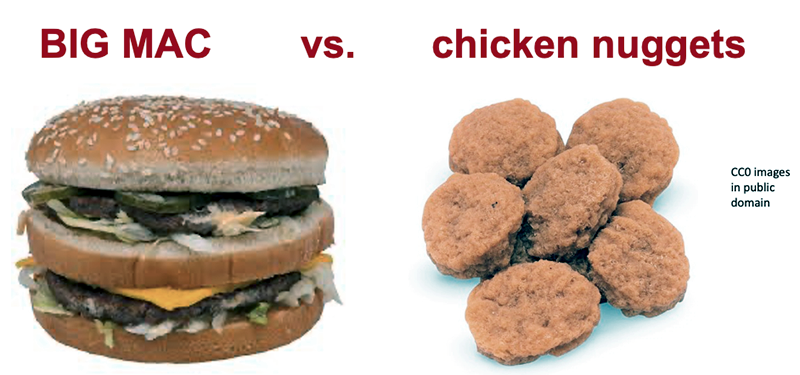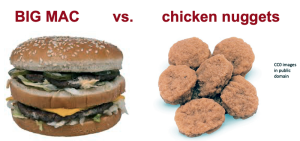31 Paragraph Length and Story Starts
Additional writing by Whitney King
Although this is not a guidebook for news reporting, we’re including one chapter that covers a few fundamentals for standard news writing style. Let’s specifically look at paragraph length and story openings.
PARAGRAPH LENGTH
Paragraph length varies depending on the type of writing. In academic writing, paragraphs can be five or more sentences in length.
However, the guidelines are different for journalistic writing. Paragraphs often contain only two or three sentences. Sometimes, a single sentence can stand alone as a paragraph.
Why? In journalism, varied audiences may read your writing, so you want the content to seem inviting. Long paragraphs can appear intimidating and overwhelming.

Here’s a McDonald’s fast-food analogy. (And even if you’re a vegetarian or don’t like fast food, you can still understand the analogy.)
Academic writing is often in Big Mac style, with two all-beef patties, special sauce, lettuce, cheese, pickles, onions and a sesame-seed bun all assembled into a single paragraph.
However, journalistic writing more closely resembles chicken nuggets. Media writers want to offer a short, tasty paragraph at the start. The opening paragraph entices readers to continue, much like one chicken nugget can tempt a diner to eat another one.
Similarly, journalists usually write concise sentences of no more than 25 words per sentence, although there is no iron-clad rule for sentence length.
Also, each direct quote should be a self-contained paragraph. Here is an example of a direct quote that should stand alone as its own paragraph in journalistic writing:
“At first, many college journalism students struggle with shortening their paragraphs and sentences,” the instructor said. “In other courses, they have been rewarded for length instead of brevity.”
CHILDREN’S STORY EXAMPLE
As a demonstration of the chapter’s opening concepts, we’ll convert a children’s story, “The Three Little Pigs,” into a news story.
In the style of fable writing, the traditional story begins something like this:
Once upon a time there was an old mother pig who had three little pigs and not enough food to feed them. So when they were old enough, she sent them out into the world to seek their fortunes.
In journalistic style, though, we want to give readers the most recent information. Most news stories are NOT in chronological order, meaning they don’t start with “Once upon a time …” The focus should be on timeliness and relevance.
Media writers will often open with the latest information based on the story’s current resolution, providing multiple elements of who, what, where, when, why and how. News writing texts refer to the story opening as the lead (or alternatively spelled the lede).
PARAGRAPH 1 – Three little pigs are safe today after they tricked a big bad wolf in Aesop’s Acres.
Next, it’s often a good strategy to include a supporting quote. This can show that the writer has actively collected information for the story. You shouldn’t give your own opinions in journalistic writing, but you can include the opinions of others through quotations.
PARAGRAPH 2 – “We gave that wolf a lesson in modern building technology,” Little Pig III said while standing in front of his unscathed brick home.
Skilled writers provide clear transitions. After the story opening and an important supporting quote or detail, they may use a transition to let the rest of the story unfold in a natural sequence, sometimes chronologically. Here are examples for the third and fourth paragraphs of our children’s story rewrite:
PARAGRAPH 3 – Little Pig I and Little Pig II said they watched in helpless fear Sunday morning as the wolf blew their houses to destruction.
PARAGRAPH 4 – The wolf destroyed the straw home of Little Pig I at approximately 9 a.m., according to a police report. One hour later, the wolf demolished Little Pig II’s home, which was built of sticks.
The story could continue chronologically to explain how the little pigs used a pot of boiling water to trick the wolf at Little Pig III’s brick home.
MORE ABOUT PARAGRAPH LENGTH
Now let’s return to that fast-food analogy.

Some people may look at the following paragraph and decide that it will require too much effort to read.
Three little pigs are safe today after they tricked a big bad wolf in Aesop’s Acres.. “We gave that wolf a lesson in modern building technology,” Little Pig III said while standing in front of his unscathed brick home. “We gave that wolf a lesson in modern building technology,” Little Pig III said while standing in front of his unscathed brick home. Little Pig I and Little Pig II said they watched in helpless fear Sunday morning as the huffing, puffing wolf blew their respective houses to destruction. The wolf destroyed the straw home of Little Pig I at approximately 9 a.m., according to a police report. One hour later, the wolf demolished Little Pig II’s home, which was built of sticks. However …
If we break that big paragraph into smaller pieces that are easier to digest, we tempt readers to continue one paragraph at a time.
Three little pigs are safe today after they tricked a big bad wolf in Aesop’s Acres.
“We gave that wolf a lesson in modern building technology,” Little Pig III said while standing in front of his unscathed brick home.
Little Pig I and Little Pig II said they watched in helpless fear Sunday morning as the wolf blew their respective houses into small pieces.
A wolf destroyed the home of Little Pig I at approximately 9 a.m., according to a police report. One hour later, the wolf demolished Little Pig II’s home, which was built of sticks.
(story continues with short paragraphs)
Here are the basic concepts to remember for journalistic writing style:
- Write in short paragraphs, typically no more than three sentences per paragraph.
- Write concise, direct sentences, often no more than 25 words per sentence.
- At the start of a news summary, focus on the most recent information, including as much as possible about who, what, where, when, why and how.
MORE EXAMPLES
The following set of flip card examples may help you better understand how to craft your story openings.
EVEN MORE EXAMPLES
The following juxtaposed story openings provide examples of how to start with the most recent and newsworthy information.
News Example (use the middle slider to toggle between two versions of the opening sentence)
Sports Example (use the middle slider to toggle between two versions of the opening sentence)

